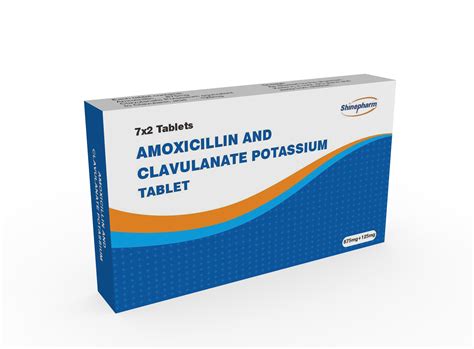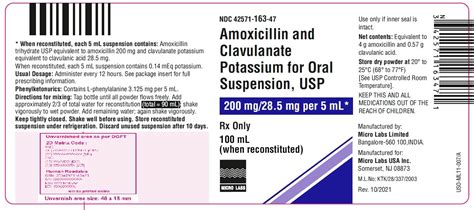Intro
Discover Amoxicillin And Clavulanate Potassium uses, a broad-spectrum antibiotic treating bacterial infections, pneumonia, and skin infections, with clavulanate potassium enhancing effectiveness against resistant strains.
The combination of amoxicillin and clavulanate potassium is a widely used antibiotic that has been effective in treating various bacterial infections. This medication is commonly prescribed to individuals who are suffering from infections caused by bacteria that produce beta-lactamase, an enzyme that can make bacteria resistant to other antibiotics. The importance of understanding the uses of amoxicillin and clavulanate potassium cannot be overstated, as it is crucial for individuals to be aware of the benefits and potential risks associated with this medication.
Amoxicillin and clavulanate potassium are two distinct components that work together to combat bacterial infections. Amoxicillin is a penicillin-type antibiotic that works by inhibiting the growth of bacteria, while clavulanate potassium is a beta-lactamase inhibitor that helps to prevent bacteria from developing resistance to amoxicillin. This combination of ingredients makes amoxicillin and clavulanate potassium a powerful tool in the fight against bacterial infections. The uses of this medication are diverse, ranging from treating respiratory tract infections to skin and soft tissue infections.
The combination of amoxicillin and clavulanate potassium has been shown to be effective in treating a wide range of bacterial infections, including those affecting the respiratory tract, skin, and urinary tract. This medication is often prescribed to individuals who are suffering from pneumonia, bronchitis, and other respiratory infections. Additionally, amoxicillin and clavulanate potassium are used to treat skin and soft tissue infections, such as abscesses, cellulitis, and wound infections. The versatility of this medication makes it an essential component of many treatment plans, and its uses continue to expand as new research emerges.
Introduction to Amoxicillin and Clavulanate Potassium

How Amoxicillin and Clavulanate Potassium Work
The mechanism of action of amoxicillin and clavulanate potassium involves the inhibition of bacterial cell wall synthesis and the prevention of beta-lactamase production. Amoxicillin works by binding to penicillin-binding proteins (PBPs) located inside the bacterial cell wall, resulting in the inhibition of cell wall synthesis and ultimately leading to the death of the bacterial cell. Clavulanate potassium, on the other hand, works by inhibiting the production of beta-lactamase, an enzyme that can break down amoxicillin and render it ineffective. By preventing the production of beta-lactamase, clavulanate potassium helps to ensure that amoxicillin can effectively inhibit bacterial cell wall synthesis and eliminate the infection.Benefits of Amoxicillin and Clavulanate Potassium

Common Uses of Amoxicillin and Clavulanate Potassium
The common uses of amoxicillin and clavulanate potassium include: * Respiratory tract infections, such as pneumonia, bronchitis, and sinusitis * Skin and soft tissue infections, such as abscesses, cellulitis, and wound infections * Urinary tract infections, such as pyelonephritis and cystitis * Dental infections, such as abscesses and pericoronitis * Other bacterial infections, such as septicemia and meningitisSide Effects of Amoxicillin and Clavulanate Potassium

Precautions and Contraindications
There are some precautions and contraindications to be aware of when taking amoxicillin and clavulanate potassium. Some of the key precautions include: * Allergic reactions: Individuals who are allergic to penicillin or other beta-lactam antibiotics should not take amoxicillin and clavulanate potassium. * Pregnancy and breastfeeding: Amoxicillin and clavulanate potassium should be used with caution in pregnant and breastfeeding women, as there is limited data available on its safety in these populations. * Kidney and liver disease: Individuals with kidney or liver disease should use amoxicillin and clavulanate potassium with caution, as it may exacerbate these conditions. * Interactions with other medications: Amoxicillin and clavulanate potassium may interact with other medications, such as blood thinners and certain antibiotics.Dosage and Administration of Amoxicillin and Clavulanate Potassium

Interactions with Other Medications
Amoxicillin and clavulanate potassium may interact with other medications, such as: * Blood thinners, such as warfarin * Certain antibiotics, such as tetracycline and erythromycin * Probenecid, a medication used to treat gout * Methotrexate, a medication used to treat cancer and autoimmune disordersConclusion and Future Directions

What is amoxicillin and clavulanate potassium used for?
+Amoxicillin and clavulanate potassium is a combination antibiotic used to treat various bacterial infections, including respiratory tract infections, skin and soft tissue infections, and urinary tract infections.
How does amoxicillin and clavulanate potassium work?
+Amoxicillin and clavulanate potassium work by inhibiting the growth of bacteria and preventing the production of beta-lactamase, an enzyme that can make bacteria resistant to other antibiotics.
What are the common side effects of amoxicillin and clavulanate potassium?
+The common side effects of amoxicillin and clavulanate potassium include gastrointestinal upset, allergic reactions, and central nervous system effects, such as dizziness and headache.
